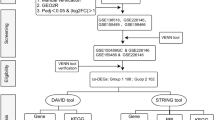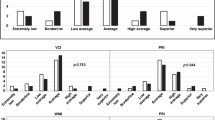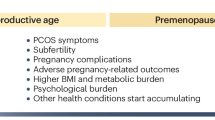Abstract
In both obese and nonobese women, polycystic ovary syndrome (PCOS) is essentially a disorder of hyperinsulinemic insulin resistance, and it may be heralded by precocious pubarche (PP; appearance of pubic hair in girls aged <8 y). The risk of progression from PP to PCOS is related to low birth weight, but there are no early biochemical markers of this risk. As increased plasminogen activator-inhibitor type 1 (PAI-1) activity (act) is an early marker of cardiovascular risk in PCOS, we have sought abnormalities in young girls with PP. In 33 young PP girls (age range 6–11 y), PAI-1-act was increased (mean + SEM: 15.6 ± 1.5 IU/mL) compared with age-, sex-, and pubertal stage–matched controls (n = 13, 10.7 ± 1.9, p < 0.05). PAI-1-act levels were inversely related to birth weight SD score (r = −0.33, p < 0.05), and PAI-1-act levels were therefore higher in PP girls with low birth weights (n = 14, 19.5 ± 2.5 IU/mL) than normal birth weights (n = 19, 12.8 ± 1.5, p < 0.01). During longitudinal observation in 10 PP girls (mean time interval 2.7 y), PAI-1-act levels in early puberty were positively related to postmenarcheal insulin levels (mean serum insulin SDS postoral glucose, r = 0.65, p < 0.05), and showed a similar relationship to postmenarcheal testosterone levels (r = 0.61, p = 0.06). Together with low birth weight, increased plasma PAI-1-act levels in early pubertal PP girls may indicate those girls with greater risk of developing hyperinsulinemic-hyperandrogenism features of PCOS.
Similar content being viewed by others
Log in or create a free account to read this content
Gain free access to this article, as well as selected content from this journal and more on nature.com
or
Abbreviations
- PCOS:
-
polycystic ovary syndrome
- PP:
-
precocious pubarche
- PAI-1:
-
plasminogen activator-inhibitor type 1
- PAI-1-act:
-
plasminogen activator-inhibitor type 1 activity
- t-PA:
-
tissue plasminogen activator
- DHEAS:
-
dehydroepiandrosterone-sulfate
References
Ibáñez L, DiMartino-Nardi J, Potau N, Saenger P 2000 Premature adrenarche—normal variant or forerunner of adult disease?. Endocr Rev 21: 671–696
Ibáñez L, Potau N, Zampolli M, Riqué S, Saenger P, Carrascosa A 1997 Hyperinsulinemia and decreased insulin-like growth factor binding protein-1 are common features in prepubertal and pubertal girls with a history of premature pubarche. J Clin Endocrinol Metab 82: 2283–2288
Ibáñez L, Potau N, Chacón P, Pascual C, Carrascosa A 1998 Hyperinsulinemia, dyslipidaemia and cardiovascular risk in girls with a history of premature pubarche. Diabetologia 41: 1057–1063
Ibáñez L, de Zegher F, Potau N 1999 Anovulation after precocious pubarche: early markers and time course in adolescence. J Clin Endocrinol Metab 84: 2691–2695
Ibáñez L, Potau N, Virdis R, Zampolli M, Terzi C, Gussinyé M, Carrascosa A, Vicens-Calvet E 1993 Postpubertal outcome in girls diagnosed of premature pubarche during childhood: increased incidence of functional ovarian hyperandrogenism. J Clin Endocrinol Metab 76: 1599–1603
Dunaif A, Finegood DT 1996 β-Cell dysfunction independent of obesity and glucose intolerance in the polycystic ovary syndrome. J Clin Endocrinol Metab 81: 942–947
Legro RS, Kunselman AR, Dodson WC, Dunaif A 1999 Prevalence and predictors of risk for type 2 diabetes mellitus and impaired glucose tolerance in polycystic ovary syndrome: a prospective, controlled study in 254 affected women. J Clin Endocrinol Metab 84: 165–169
Ehrmann DA, Barnes RB, Rosenfield RL, Cavaghan MK, Imperial J 1999 Prevalence of impaired glucose tolerance and diabetes in women with polycystic ovary syndrome. Diabetes Care 22: 141–146
Mather KJ, Kwan F, Corenblum B 2000 Hyperinsulinemia in polycystic ovary syndrome correlates with increased cardiovascular risk independent of obesity. Fertil Steril 73: 150–156
Wild S, Pierpoint T, McKelgue P, Jacobs H 2000 Cardiovascular disease in women with polycystic ovary syndrome at long-term follow-up: a retrospective cohort study. Clin Endocrinol 52: 595–600
Ibáñez L, Potau N, Francois I, de Zegher F 1998 Precocious pubarche, hyperinsulinism and ovarian hyperandrogenism in girls: relation to reduced fetal growth. J Clin Endocrinol Metab 83: 3558–3662
Ibáñez L, Potau N, de Zegher F 1999 Precocious pubarche, dyslipidemia, and low IGF binding protein-1 in girls: relation to reduced prenatal growth. Pediatr Res 46: 320–322
Ibáñez L, Valls C, Potau N, Marcos MV, de Zegher F 2000 Sensitization to insulin in adolescent girls to normalize hirsutism, hyperandrogenism, oligomenorrhea, dyslipidemia, and hyperinsulinism after precocious pubarche. J Clin Endocrinol Metab 85: 3526–3530
Ibáñez L, Valls C, Potau N, Marcos MV, de Zegher F 2001 Polycystic ovary syndrome after precocious pubarche: ontogeny of the low-birthweight effect. Clin Endocrinol 55: 667–672
Sprengers DE, Kluft C 1987 Plasminogen activators and inhibitors. Blood 69: 381–387
Hamsten A, Wiman B, de Faire U, Blombäck M 1985 Increased plasma levels of a rapid inhibitor of tissue plasminogen activator in young survivors of myocardial infarction. N Engl J Med 313: 1557–1563
Meade TW, Brozovic M, Chakrabarti RR, Haines AP, Imeson JD, Mellows S, Miller GJ, North WRS, Stirling Y, Thompson SG 1986 Haemostatic function and ischemic heart disease: principal results of the Northwick Park Heart Study. Lancet 2: 533–537
Ernst E 1991 Fibrinogen. An independent risk factor for cardiovascular disease. BMJ 303: 596–597
Kohler HP, Grant PJ 2000 Plasminogen-activator inhibitor type 1 and coronary artery disease. N Engl J Med 342: 1792–1801
Byberg L, Keighe PM, Zethelius B, Lithell HO 2000 Birthweight and the insulin resistance syndrome: association of low birthweight with truncal obesity and raised plasminogen activator inhibitor-1 but not with abdominal obesity or plasma lipid disturbances. Diabetologia 43: 54–60
Sampson M, Kong C, Patel A, Unwin R, Jacobs HS 1996 Ambulatory blood pressure profiles and plasminogen activator inhibitor (PAI-1) activity in lean women with and without the polycystic ovary syndrome. Clin Endocrinol 45: 623–629
Atiomo WU, Bates SA, Condon JE, Shaw S, West JH, Prentice AG 1998 The plasminogen activator system in women with polycystic ovary syndrome. Fertil Steril 69: 236–241
Juhan-Vague I, Alessi MC, Vague P 1991 Increased plasma plasminogen activator inhibitor I levels: a possible link between insulin resistance and atherothrombosis. Diabetologia 34: 457–462
Juhan-Vague I, Alessi MC 1997 PAI-1, obesity, insulin resistance and risk of cardiovascular events. Thromb Haemost 78: 656–660
Potter van Loon BJ, Kluft C, Radder JK, Blankenstein MA, Meinders AE 1993 The cardiovascular risk factor plasminogen activator inhibitor type 1 is related to insulin resistance. Metabolism 42: 945–949
Mansfield MW, Heywood DM, Grant PJ 1996 Circulating levels of factor VII, fibrinogen, and von Willebrand factor and features of insulin resistance in first-degree relatives of patients with NIDDM. Circulation 94: 2171–2176
Juhan-Vague I, Roul C, Alessi MC, Ardissone JP, Heim M, Vague P 1989 Increased plasminogen activator inhibitor activity in non-insulin-dependent diabetic patients—relationship with plasma insulin. Thromb Haemost 61: 370–373
Barazzoni R, Zanetti M, Davanzo G, Kiwanuka E, Carraro P, Tiengo A, Tessari P 2000 Increased fibrinogen production in type 2 diabetic patients without detectable vascular complications: correlation with plasma glucagon concentrations. J Clin Endocrinol Metab 85: 3121–3125
Marshall WA, Tanner JM 1969 Variations in the pattern of pubertal changes in girls. Arch Dis Child 44: 291–303
Hammer LD, Kraemer HC, Wilson DM, Ritter PL, Dornbusch SM 1991 Standardized percentile curves of body-mass index for children and adolescents. Arch Pediatr Adolesc Med 145: 259–263
Rosenfield RL 1994 Normal and almost normal precocious variations in pubertal development. Premature pubarche and premature thelarche revisited. Horm Res 41( suppl 2): 7–13
New MI, Lorenzen F, Lerner AJ, Kohn B, Oberfield SE, Pollack MS, Dupont B, Stoner E, Levy DJ, Pang S, Levine LS 1983 Genotyping steroid 21-hydroxylase deficiency: hormonal reference data. J Clin Endocrinol Metab 56: 320–325
Sakkal-Alkaddour H, Zhang L, Yang X, Chang YT, Kappy M, Slover RS 1996 Studies of 3β-hydroxysteroid dehydrogenase genes in infants and children manifesting premature pubarche and increased adrenocorticotropin-stimulated Δ5-steroid levels. J Clin Endocrinol Metab 81: 3961–3965
The Expert Committee on the Diagnosis and Classification of Diabetes Mellitus 1997 Report of the Expert Committee on the Diagnosis and Classification of Diabetes Mellitus. Diabetes Care 20: 1183–1197
Kluft C, Jie AFH, Rijken DC, Verheijen JH 1988 Daytime fluctuations in blood of tissue-type plasminogen activator (t-PA) and its fast-acting inhibitor (PAI-1). Thromb Haemost 59: 329–332
Chmielewska J, Wiman B 1986 Determination of plasminogen activator and its “fast” inhibitor in plasma. Clin Chem 32: 482–485
Dunaif A 1997 Insulin resistance and the polycystic ovary syndrome: mechanism and implications for pathogenesis. Endocr Rev 18: 774–800
Velázquez EM, Mendoza SG, Wanf P, Glueck CJ 1997 Metformin therapy is associated with a decrease in plasma plasminogen activator inhibitor-1, lipoprotein (a), and immunoreactive insulin levels in patients with the polycystic ovary syndrome. Metabolism 46: 454–457
Ehrmann DA, Schneider DJ, Sobel BE, Cavaghan MK, Imperial J, Rosenfield RL, Polonsky KS 1997 Troglitazone improves defects in insulin action, insulin secretion, ovarian steroidogenesis, and fibrinolysis in women with polycystic ovary syndrome. J Clin Endocrinol Metab 82: 2108–2116
Glueck CJ, Wag P, Fontaine R, Tracy T, Sieve-Smith L 1999 Metformin-induced resumption of normal menses in 39 of 43 (91%) previously amenorrheic women with the polycystic ovary syndrome. Metabolism 48: 511–519
Juhan-Vague I 1996 Haemostatic parameters and vascular risk. Atherosclerosis 124( suppl): S49–S55
Wiman B 1996 Plasminogen activator inhibitor 1 in thrombotic disease. Curr Opin Hematol 3: 372–378
Balasa VV, Gruppo RA, Glueck CJ, Stroop D, Becker A, Pillow A, Wang P 1999 The relationships of mutations in the MTHFR, prothrombin, and PAI-1 genes to plasma levels of homocysteine, prothrombin, and PAI-1 in children and adults. Thromb Haemost 81: 739–744
Dawson S, Hamsten A, Wiman B, Henry A, Humphries S 1991 Genetic variation at the plasminogen activator inhibitor-1 locus is associated with altered levels of plasminogen activator inhibitor-1 activity. Arterioscler Thromb Vasc Biol 11: 183–190
Glueck CJ, Phillips H, Cameron D, Wang P, Fontaine RN, Moore SK, Sieve-Smith L, Tracy T 2000 The 4G/4G polymorphism of the hypofibrinolytic plasminogen activator inhibitor type 1 gene: an independent risk factor for serious pregnancy complications. Metabolism 49: 845–852
Glueck CJ, Wang P, Fontaine RN, Sieve-Smith L, Tracy T, Moore SK 1999 Plasminogen activator inhibitor activity: an independent risk factor for the high miscarriage rate during pregnancy in women with polycystic ovary syndrome. Metabolism 48: 1589–1595
Iacoviello L, Burzotta F, di Castelnuovo A, Zito F, Marchioli R, Donati MB 1998 The G/5G polymorphism of PAI-1 promoter gene and the risk of myocardial infarction: a meta-analysis. Thromb Haemost 80: 1029–1030
Alessi MC, Juhan-Vague I, Kooistra T, Declerck PJ, Collen D 1988 Insulin stimulates the synthesis of plasminogen activator inhibitor 1 by the human hepatocellular cell line Hep G2. Thromb Haemost 60: 491–494
Schneider DJ, Sobel BE 1996 Synergistic augmentation of expression of plasminogen activator inhibitor type-1 induced by insulin, very-low-density lipoproteins, and fatty acids. Coronary Artery Dis 7: 813–817
Nordt TK, Sawa H, Fujii S, Sobel BE 1995 Induction of plasminogen activator inhibitor type-1 (PAI-1) by proinsulin and insulin in vivo. Circulation 91: 764–770
Folsom AR, Qamhieh HT, Wing RR, Jeffery RW, Stinson VL, Kuller LH, Wu KK 1993 Impact of weight loss on plasminogen activator inhibitor (PAI-1), factor VII, and other hemostatic factors in moderately overweight adults. Arterioscler Thromb 13: 162–169
Sironi L, Mussoni L, Prati L, Baldassarre D, Camera M, Banfi C, Tremoli E 1996 Plasminogen activator inhibitor-1 (PAI-1) synthesis and mRNA expression in HepG2 cells are regulated by VLDL. Arterioscler Thromb Vasc Biol 16: 89–96
Folsom AR, Wu KK, Davis CE, Conlan MG, Sorlie PD, Szklo M 1991 Population correlates of plasma fibrinogen and factor VII, putative cardiovascular risk factors. Atherosclerosis 91: 191–205
Acknowledgements
The authors thank Dr. Lluis Masana from The University Rovira i Virgili, Reus, Spain, for his methodological advice, Maria Jesús Gras for hormone measurements, and Inge Laleeuwe for editorial assistance.
Author information
Authors and Affiliations
Corresponding author
Additional information
Supported by a Visiting Scholarship from the European Society for Paediatric Endocrinology and by the Agència per a la Recerca i la Docència from the Hospital Materno-Infantil Vall d'Hebron, Barcelona, Spain.
Rights and permissions
About this article
Cite this article
Ibáñez, L., Aulesa, C., Potau, N. et al. Plasminogen Activator Inhibitor-1 in Girls with Precocious Pubarche: A Premenarcheal Marker for Polycystic Ovary Syndrome?. Pediatr Res 51, 244–248 (2002). https://doi.org/10.1203/00006450-200202000-00019
Received:
Accepted:
Issue date:
DOI: https://doi.org/10.1203/00006450-200202000-00019
This article is cited by
-
NMR-based metabolic profiling of children with premature adrenarche
Metabolomics (2022)
-
Clinical spectrum of premature pubarche: Links to metabolic syndrome and ovarian hyperandrogenism
Reviews in Endocrine and Metabolic Disorders (2009)



